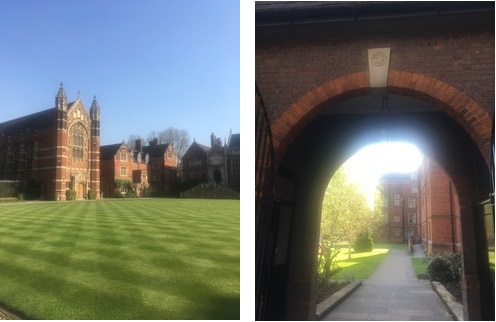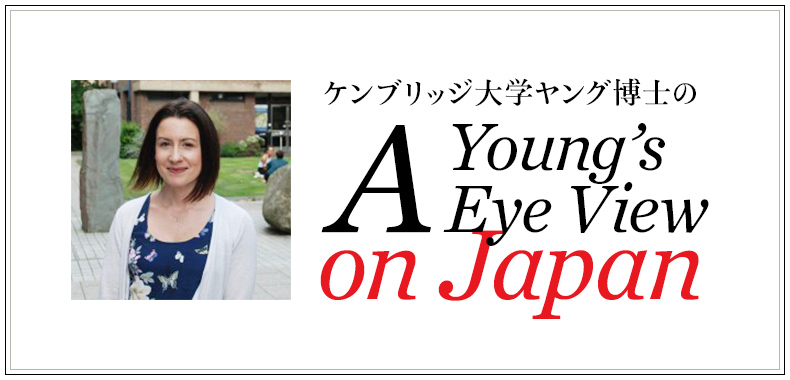Surprising Symbols
Through studying Japanese language and literature I often have cause to reflect on the symbolic meanings and functions of words. However, there is an even more intriguing symbol in Selwyn College that has a connection to Japan. For carved into a stone above the archway next to the College Library is the likeness of a swastika. However, this symbol (in Japanese, a manji) is also contained within a circle, indicating that it is in fact the coat of arms of the Hachisuka family.
have cause to do ~する理由がある / reflect on ~を熟考する、じっくり検討する / symbolic meaning 象徴的意味 / function 機能、働き / intriguing 興味をそそる、興味深い / have a connection to ~と関係がある、つながりがある / carve A into B AをBに刻み込む、彫る / archway アーチ道、アーチ状の屋根のある通路 / next to ~の隣に、~に隣接して / likeness 似たもの、類似物 / swastika まんじ、かぎ十字 / be contained within ~の中に含まれる、包含される / indicate that ~であることを示す、意味する / coat of arms 紋章 / the Hachisuka family 蜂須賀家 (尾張国を出自とする氏族で、木下藤吉郎 (後の豊臣秀吉) に仕えた蜂須賀小六が有名)

LEFT: A view across ‘Old Court’ towards the College Chapel and, to its right, the Master’s Lodge.
RIGHT: The full arch with a view into Ann’s Court. The library entrance is on the left.
Professor Richard Bowring, who served as Master of Selwyn College from 2000 to 2013, is a renowned scholar of Japanese Studies and once investigated the origins of this symbol within the college’s architecture. He learned that in 1929, almost half a century after Selwyn was founded in 1882, the College received considerable donations from three Japanese men who had been hosted within the grounds and were committed to its scholarly ambitions. Those men were Tokugawa Raitei of the Kii Wakayama branch of that family, Hachisuka Masauji and Sawada Kiyoshi. The Hachisuka crest carved into the building’s stone honours its namesake’s contribution.
renowned 名高い、著名な / scholar (人文科学系の) 学者 / investigate ~を調査する、研究する / origins 発端、起源 / architecture 建築、建築様式 / found ~を設立する、創立する / considerable かなりの、相当な / donation 寄付 / host ~を客としてもてなす、宿泊させる / be committed to ~に専心する、尽力する / scholarly 学術的な、学究的な / ambition 野心、大志 / Tokugawa Raitei 徳川頼貞 (1892-1954。名は「よりさだ」だが、音読みして「らいてい」とも。紀州徳川家の第16代当主で、「音楽の殿様」と呼ばれた。ケンブリッジ大学音楽理論科中退) / Hachisuka Masauji 蜂須賀正氏 (1903-1953。旧徳島藩主蜂須賀家の第18代当主で、ケンブリッジ大学モードリンカレッジ時代は鳥類の研究に没頭したことで知られる) / Sawada Kiyoshi (氏名の漢字表記不祥。1903-1994。1925年に神戸からケンブリッジ大学セルウィンカレッジに入学し、1927年に経済学の学位を取得。在学中はテニスやスキーの選手として活躍したという)/ crest 紋章 / honour ~に敬意を示す / namesake 名前をもらった人、ちなんだ名前の人 / contribution 寄付、寄贈

A close-up of the ’Selwyn Swastika’, as it is known.
The manji signifies luck and virtue and is used on Japanese maps to indicate the location of Buddhist temples. However, amid preparations for the Tokyo 2020 Olympics there are apparently motions to change this symbol out of concern that visitors will misread it as a Nazi Hakenkreuz. In fact, the orientations of both symbols are opposite, with the hooks in the manji curving to the left rather than to the right. It saddens me that the proposed solution for possible miscomprehension is to delete the source of confusion rather than teach the different layers of meaning in a single image or idea. As educators, we ask that students never judge a book by its cover. I hope that no matter how absorbed our students are in their books, or how worried they are about their June exams, they will remember to look up as they enter the Library and be curious about structures around them.
signify ~を意味する、表す / virtue 徳、善 / Buddhist temple 仏教寺院、仏閣 / amid ~の最中に、渦中に / preparation for ~の準備 / apparently ~のように見える、どうやら~らしい / motion to do ~すべきだという申し立て、~する意向 / out of concern 懸念から、心配から / misread A as B AをBだと読み違える、誤解する / Hakenkreuz ハーケンクロイツ (ドイツ語で「まんじ、かぎ十字」を意味するが、ナチスのシンボルとして使用された) / orientation 方向、向き / opposite 正反対の、逆の / hook (文字の) はね、かぎ / sadden ~を悲しませる / proposed 提案された~、~案 / solution 解決、解決策 / miscomprehension 誤解、錯誤 / delete ~を削除する、取り除く /confusion 混同、取り違え / layers of ~の層、何層にも重なった~ / educator 教育者、教師 / judge a book by its cover 外見で中身を判断する / no matter how どんなに~であろうとも / be absorbed in ~にすっかり心を奪われる、夢中になる / be worried about ~が気になる、心配である / enter ~に入る / be curious about ~に興味を持つ、~が気になる / structure 構造、作り
*Sincere thanks to Professor Richard Bowring and Dr David L Smith for sharing their knowledge on the ‘Selwyn Swastika’.



